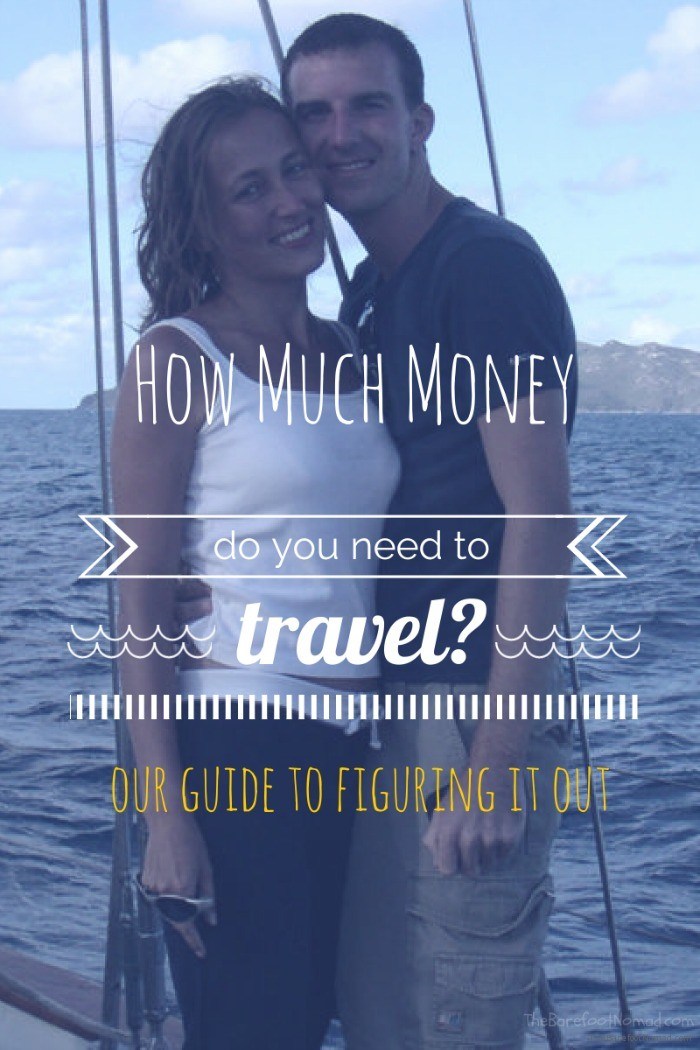Whether you’re backpacking on a round the world trip, spending your summer in a villa in Europe (lucky you!), or planning to spend a few weeks driving around the USA, one of the hardest questions you’ll have to answer is: How much money do I need to travel?
Charles and I have had to answer this question for every trip we’ve taken since we started traveling together in 2002. Along the way, we’ve found some helpful tips and resources for figuring out a budget for even the most complex of trips.
We’re going to be doing this a bit old school today, but it’s easy and it works. Before you start, grab a pen and paper, a napkin, or just get ready to jot down some quick notes on your computer.
Where do I start?
Figuring out a realistic ballpark figure for your trip shouldn’t be a long, painful process. To give you a good idea of how much you’ll need should take less than a half hour.
I’m a huge fan of the back of a napkin approach for getting a general idea of costs. Once you get a good estimate and decide to go ahead with your plans, you can play with the numbers to get a more precise figure. I find that a quick estimate is almost always bang on.
How much your trip costs will depend on a few things that you’ll need to figure out before you can crunch numbers. To begin, sort this information out before you start:
- Where you’re going
- How long you’ll be in each destination
- How many people are traveling together
- Your style of traveling, be it hostel bunks and street food, cooking while staying in homes or apartments rental, or higher end hotels and nice restaurants
- When you’ll be at your destination (prices are higher during peak season)
What you’ll need to spend before you leave
These include immunizations, travel insurance and gear like a new backpack or new camera.
Immunizations and Vaccines
To figure out what vaccinations you need, check out the incredibly helpful tool on the Center for Disease Control’s (CDC) website. Then, do a Google search for travel vaccination clinics for your specific city, and pull the costs for the vaccines from there. Don’t forget to add in the cost of an initial consultation and any subsequent visits.
Tip: You may be able to save money by having the vaccinations done directly at the pharmacy or your family doctor’s office if these services are offered where you live. Depending on the vaccination and who administered it, it might also be eligible as a personal tax write-off.
Travel Insurance
A good place to get a baseline quote for travel insurance is SafetyWing Nomad Insurance, who offers travel insurance to residents of over 10 countries. We’ve found their prices to be among the lowest.
SafetyWing Nomad Insurance covers nearly every country on the planet.
Travel insurance can be pretty confusing and full of jargon. If you’re from Canada, check out Canadian Travel Insurance Review, while New Zealanders can check out New Zealand Travel Insurance Review for tips and overviews of travel insurance. Australians can take a look at Australia Travel Insurance Review, a website for independent, in depth reviews on Australian travel insurance companies.
Airfare
To get a baseline price for airfare, you should look at about a month’s worth of prices. We use Google Flights (which will show a month’s worth of fares), or Skyscanner, which will let you look at up to an entire year’s worth of prices in one search.
Click here to search Skyscanner.
Want to get a great deal on your flight? Check out our post Six Quick Steps to Nailing the Cheapest Flight. If you still have some flexibility in where you’re going, check out our tips on how to find the cheapest flights from your destination.
Tip: Don’t forget to add in extra charges, including charges for extra carry-on and checked baggage. You can find baggage costs for almost every airline out there at SeatGuru.com.
Accommodation
Where you stay is one of the biggest variables in travel. You can spend anywhere from thousands a night on luxury suites to staying for free with a friend or Couchsurfing.
Are you a luxury traveler who only stays in five star hotels, a family that does best with a house or condo rental, an ultra-budget backpacker who stays in hostel dorms, or even someone who’s willing to test out free Couchsurfing accommodations?
Long Term Travelers
If you’re planning to stay in one place for a month or more and live like a local you can get some great information on monthly rents from Numbeo, a seriously addictive crowd-sourced cost-of-living comparison site.
Check out listings on Airbnb as well, as this will give you a good baseline for long term accommodation aimed more at tourists (with more modern conveniences).
If you’re traveling long term, don’t forget to factor in discounts for weekly or monthly stays. As a general rule of thumb, we’ve found that most home rentals charge the same for a month long stay as a two week stay. Hotels and hostels also often offer good weekly and monthly discounts.
Backpackers
We like to use Hostelz.com to get baseline prices for dorm rooms and budget hotels. They have a huge selection of rooms all over the world.
Vacationers
We love Booking.com for budgeting for shorter stays, as they have a huge selection of hotel rooms and have a lightning fast search engine. Numbeo also has a hotel prices, but we find that their numbers are a bit harder to navigate than simply looking at a hotel search engine.
Food
Where and what you eat is a huge factor in your travel budget.
In general, eating out costs a lot more than making all (or some) of your own meals, with the exception of countries like Thailand where cheap, delicious meals often cost less than hassling with cooking for yourself.
Eating in
Use the awesome Numbeo, a crowd-sourced cost-of-living comparison site, to get ballpark prices on standard groceries like milk and bread.
Tip: To get an idea of your own personal costs, check out the prices for your home country as well so you have a proper baseline to compare it to. It generally helps if you already have a good idea of what your current eating in costs are as well.
Eating out
Again, Numbeo is a fantastic resource for getting the average cost of restaurant meals, whether you prefer inexpensive local fare, fast food, or a sit down restaurant.
Tip: The more meals you eat out the quicker your costs will skyrocket. Try saving some cash by eating in for breakfasts and bagging the occasional lunch.
Alcohol
It’s pretty easy to spend more on alcohol than food, especially if you’re in the habit of spending evenings out drinking. You can find the cost of a bottle of beer or wine in the Market and Restaurant sections of Numbeo.
Total Food Budget
Once you pull all these numbers, you’ll need to roughly figure out how often you eat in vs out, and then figure out an average of how much you’ll spend per day.
Quick tips for saving on food: Always carry a snack, like a bag of pretzels or nuts, to stave off expensive trips to vending machines or convenience stores. Try to get breakfast included in your room rate, but if this isn’t possible try to get a kitchen (or at least a small fridge or microwave) in your room for snacks, breakfast and quick, light meals.
Transportation
We’ve included airfare in a separate category, so these tips just reflect local transport at your destination.
Again, Numbeo comes to the rescue with estimates for local taxi, bus and gasoline costs.
If you’re traveling in the USA or Canada, we love GasBuddy, which gives generally reliable crowd-sourced prices for local gas. You can also get the free iOS app for GasBuddy, or on Google Play, Blackberry App World or on Windows phone.
If you’re renting a car, we like to get a baseline price from Expedia as it saves us having to search through multiple car rental sites. Most of the time (not always!), Expedia’s price is pretty hard to beat for car rentals when you factor in the included extras. Don’t forget to add the cost of insurance.
Tip: Make sure that you factor in the cost for transportation from your arrival airport. Many budget airlines arrive in smaller airports a good hike from your destination city.
Tours
You can find some great baseline costs for tours from Viator or G Adventures. Traditionally aimed more at young backpackers, G Adventures is moving more into the family and couples markets as well.
If there are any must see locations or must do activities (like ziplining in Costa Rica or bungee jumping in New Zealand) that aren’t officially tours you can still add them here.
Personal
Any personal items you use get included here, from prescription medicines to birth control to shampoo and deodorant. Since these usually apply wherever you happen to be, you can choose to add them or not.
Entertainment
We’ve included alcohol in the food category, so this is the place to best estimate cover charges for bars, concerts, movies and the like that you might do while on your trip.
Debt and Financial
Unfortunately, creditors really don’t care that you’re on vacation. They just care about getting their payments on time. Estimate the amount you’ll need to budget for loan and credit card payments while you are gone. Though they’re not officially part of your trip, you still need to ensure that your bank account can cover the costs while you’re gone.
Don’t forget to include checking and savings account monthly fees and ATM fees. You’ll need to check with your bank for specific fees, but it might be worthwhile looking for a card with zero foreign fees if you plan on using that card while you travel.
The Bottom Line
There you have it – factor all of these things in, and you should have a pretty good idea what your trip will cost.
Don’t forget to add an extra 10-20% to your estimates to cover unexpected expenses. Life has a way of handing out the unexpected 😉
Wondering how you’re going to afford it now? Check out these posts for some help:
- How to Save Money for your Round the World Trip
- 45 Great Jobs you can do While Traveling the World (and How to Get Them)
Do you have any tips for figuring out a travel budget? Share them below – we’d love to hear what you think!







